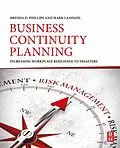Terrorism, natural disasters, or hazardous materials threaten the viability for all types of businesses. With an eye toward business scale, scope, and diversity, Business Continuity Planning: Increasing Workplace Resilience to Disasters, addresses a range of potential businesses from home-based to large corporations in the face of these threats, including the worldwide COVID-19 pandemic. Information on business continuity planning is easy to find but can be difficult to work through. Terminology, required content, and planning barriers often prevent progress. This volume solves such problems by guiding readers, step-by-step, through such actions as identifying hazards and assessing risks, writing critical functions, forming teams, and encouraging stakeholder participation. In essence, this volume serves as a business continuity planning coach for people new to the process or seeking to strengthen and deepen their ongoing efforts. By engaging stakeholders in a business continuity planning process, businesses can protect employees, customers, and their financial stability. Coupled with examples from recent disasters, planners will be able to inspire and involve stakeholders in creating a more resilient workplace. Designed for both educators and practitioners, Business Continuity Planning: Increasing Workplace Resilience to Disasters walks users through how to understand and execute the essential steps of business continuity planning. - Presents evidence-based best practices coupled with standard operating procedures for business continuity planning in a stepwise, user-oriented manner - Includes numerous examples and case studies bringing the ideas and procedures to life - Provides user-friendly materials and resources, such as templated worksheets, checklists, and procedures with clear instructions, making the volume engaging and immediately operational
Autorentext
Brenda D. Phillips, Ph.D., is the Dean of Liberal Arts and Sciences and Professor of Sociology at Indiana University South Bend. Previously, she taught emergency management at Oklahoma State University and has served as a subject-matter expert, consultant, and volunteer for multiple agencies, communities, educational institutions, and voluntary organizations. She is the author of Disaster Recovery, Mennonite Disaster Service, and Qualitative Disaster Research, the co-author of Introduction to Emergency Management, and the co-editor of Social Vulnerability to Disaster and co-author of the forthcoming Business Continuity Planning. She has written numerous peer-reviewed journal articles in the discipline of emergency management and disaster science with direct experience in researching hurricanes, tornadoes, earthquakes, tsunamis, and hazardous materials accidents, much of which has been funded by the National Science Foundation. Dr. Phillips has been invited to assist or speak at disaster programs in the United States, Canada, Mexico, People's Republic of China, Costa Rica, New Zealand, Germany, Sweden, and Australia where she has promoted evidence-based best practices for community safety.
Dr. Phillips firmly believes in the extension of faculty expertise through volunteer service.
With over thirty years of experience in the field of emergency management education, Dr. Phillips has volunteered for local emergency management planning committees and voluntary organizations, especially for high risk populations. She has served as an unpaid reviewer of city and agency emergency management plans and assisted with planning around disaster-time domestic violence, safety for people with disabilities, and elderly evacuation. She has led business continuity planning at multiple academic institutions and businesses. Her most meaningful volunteer activities have helped to rescue animals and rebuild homes (and docks that support sustainable livelihoods) after disasters.
Inhalt
Chapter One. The Challenges of Business Continuity Planning
Introduction
What Most Businesses Do (Not Do) in a Disaster
Hazards that Become (Business) Disasters
- Natural Hazards
- Tsunamis and Cascading Events
- Hurricanes and Cyclones
- Floods
- Earthquakes
- Volcanos
- Tornadoes
- Hazardous Materials
- Technological Disruptions
- Terrorism and Active Attackers
- Pandemics
- Mitigation Planning
- Preparedness and Planning
- Response Planning
- Recovery and Business Continuity Planning
- Mission fulfillment
- The financial bottom line
- Loss containment
- Customer bases
- Human resources
- Diversity in the business community
- Involvement and inclusion
- Planning is a process
- Evidence-based planning
- A culture of continuity
- Getting people's attention
- Securing a commitment from the CEO
- Lack of knowledge or understanding
- Educating and involving people on planning as a process
- Direct impacts
- Indirect impacts
- Downtime
- Displacement
- Impacts on employees
- Impacts on customers
- Businesses that fail
- Get a team together
- Establish a timeline
- Kick off the BCP effort
- Build and maintain momentum
- Sources of hazard information
- How to write up a hazard identification
- Understanding probabilities and historic trends
- Crafting Scenarios
- Kinds of losses to estimate
- Broader community impacts
- Pandemic
- Technology Disruptions
- Natural Disasters
- Prioritizing Critical Functions
- Work Teams
- Anticipating Disruptions
- Utilities
- Communication and Information Technology
- Transportation arteries and supply chains
- How utilities get back on
- The role of critical function work teams
- Site displacement
- Functional displacement
- Population displacement
- Terrorism
- Natural Disaster
- Pandemic
- Business Continuity Planning for Human Resource Management
- Preparing Employees for Disruptions
Types of Disaster Planning
The Benefits of Business Continuity Planning (BCP)
Essential Principles for BC Planning
Upcoming Chapters
Chapter Two. Setting the Stage
The Challenges of Business Continuity Planning
The Effects of Disasters on Businesses
Essential Actions for Starting the Planning Process
Chapter Three. Pre-planning Steps to Launch BCP
Introduction
Hazard Identification
Risk Assessment
Loss Estimation
Business impact analysis
Determining Acceptable Losses
Mitigating Losses
Essential Actions
Chapter Four. Parts of a Business Continuity Plan
Scenarios and Decision-Making
Critical Functions
Assets and Workarounds
Essential Partnerships
Essential Actions to Take
Chapter Five. Managing Disruptions
Introduction
Infrastructure Disruptions
Downtime Management
Displacement Management
Restoring Critical Functions
Essential Actions
Chapter Six. Managing Human Resources
Introduction
Case Examples
The Critical Role of Human Resources Management
